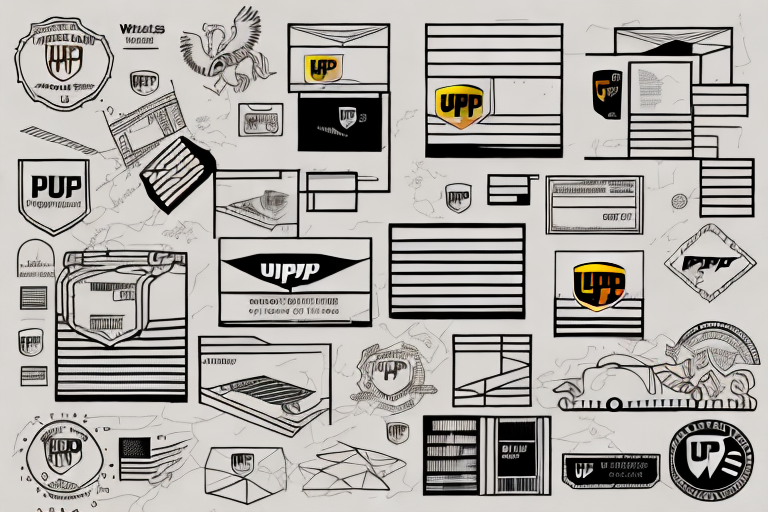Preparing Dangerous Goods for International Import with UPS Worldwide Express Freight
Shipping dangerous goods internationally involves navigating a complex landscape of regulations and requirements. Partnering with an experienced shipping company like UPS Worldwide Express Freight is essential to ensure compliance and safety. This guide delves into the essential regulations, best practices, and strategic approaches for preparing dangerous goods for international import using UPS Worldwide Express Freight.
Understanding International Regulations for Dangerous Goods
Transporting dangerous goods poses significant hazards if not managed correctly. To mitigate these risks, several international regulations are established to ensure the safe handling and transportation of such materials. The International Air Transport Association (IATA) sets the standards for air transport, while the International Maritime Organization (IMO) governs sea transport. Adhering to these regulations is crucial for compliance and safety.
Different countries may have additional regulations and restrictions on the import and export of hazardous materials. For example, the European Union's Chemicals Legislation imposes stringent requirements on certain hazardous substances. Failure to comply with these country-specific regulations can result in legal penalties, shipment delays, or safety incidents. Therefore, thorough research and adherence to both international and local regulations are imperative.
Proper labeling and packaging are fundamental components of regulatory compliance. This includes using appropriate hazard labels, durable packaging materials, and following specific guidelines tailored to each type of dangerous good. According to the United Nations Dangerous Goods Regulations (UN DGR), accurate labeling and packaging significantly reduce the risk of accidents during transportation.
The Importance of Proper Packaging for Dangerous Goods
Effective packaging safeguards dangerous goods from damage and prevents potential hazards during transit. Packaging must withstand transportation stresses and contain any leaks or spills. Compliance with the UN DGR is essential, as it categorizes dangerous goods into nine classes, each with specific packaging requirements.
Key Aspects of Proper Packaging:
- Durability: Packaging materials should resist punctures, tears, and moisture to protect the contents.
- Containment: Ensure that containers can safely hold the goods without leakage.
- Labeling: Clearly display hazard symbols and handling instructions to inform handlers and emergency responders.
- Compliance: Adhere to regulatory standards specific to each class of dangerous goods.
For instance, flammable liquids (Class 3) require containers that prevent vapor release, while corrosive materials (Class 8) need packaging resistant to chemical reactions. Partnering with experts at UPS Worldwide Express Freight can help ensure that your packaging meets all necessary standards.
Identifying Hazardous Materials and Classes
Accurate identification of hazardous materials and their corresponding hazard classes is critical for compliance and safety. The UN DGR categorizes dangerous goods into nine classes based on their primary hazard:
- Explosives
- Gases
- Flammable Liquids
- Flammable Solids
- Oxidizing Substances
- Toxic and Infectious Substances
- Radioactive Materials
- Corrosive Substances
- Miscellaneous Dangerous Goods
Each class has specific requirements for packaging, labeling, and documentation. For example, Class 2 gases must be stored in pressurized containers, while Class 6 toxic substances require secure packaging to prevent exposure. Additionally, some materials fall into multiple classes, necessitating compliance with all relevant regulations.
Understanding these classifications helps in selecting the appropriate packaging and ensures that all necessary documentation accompanies the shipment. Utilizing resources like the Environmental Protection Agency (EPA) can provide further guidance on material classifications and handling procedures.
Shipping Dangerous Goods with UPS Worldwide Express Freight
UPS Worldwide Express Freight offers robust solutions for shipping dangerous goods internationally. Their team of experts assists in navigating the complex regulations and ensures that all packaging and labeling meet international standards.
Key services include:
- Regulatory Compliance: Guidance on adhering to IATA, IMO, and UN DGR standards.
- Packaging Solutions: Access to specialized packaging materials and techniques tailored to specific hazardous goods.
- Documentation Assistance: Help with preparing accurate and complete shipping documentation, including dangerous goods declarations and Material Safety Data Sheets (MSDS).
- Tracking and Monitoring: Real-time tracking to ensure the safe and timely arrival of shipments.
In 2023, UPS Worldwide Express Freight reported a 98% on-time delivery rate for dangerous goods shipments, highlighting their reliability and expertise in this specialized area.
Essential Documentation for Shipping Dangerous Goods Internationally
Proper documentation is paramount when shipping dangerous goods internationally. Required documents include:
- Dangerous Goods Declaration: A detailed statement outlining the nature and classification of the hazardous materials.
- Material Safety Data Sheet (MSDS): Information on the properties, handling, and emergency measures related to the hazardous materials.
- Air Waybills or Bills of Lading: Transportation contracts that detail the shipment specifics.
Additionally, each package must be labeled with the appropriate UN number, hazard class, and shipping name. Including special handling instructions and emergency contact information is also crucial.
Compliance with local regulations is essential, as different countries may have varying documentation requirements. Utilizing platforms like ShipScience can streamline the documentation process, ensuring accuracy and completeness.
Managing the Risks of Transporting Dangerous Goods
Transporting dangerous goods inherently involves risks, but effective management strategies can mitigate these dangers. Key risk management practices include:
- Proper Packaging and Labeling: Ensures containment and clear communication of hazards.
- Comprehensive Documentation: Facilitates regulatory compliance and informed handling.
- Experienced Shipping Partners: Collaborating with companies like UPS Worldwide Express Freight provides access to expertise and specialized resources.
- Employee Training: Ensures that all personnel understand handling procedures and emergency protocols.
- Emergency Response Planning: Developing and regularly updating plans for accidents or spills.
Statistics from the Federal Emergency Management Agency (FEMA) indicate that proper training and emergency preparedness can reduce incident rates by up to 40%. Investing in these areas enhances safety and minimizes potential liabilities.
Tips for Safe Handling and Transport of Dangerous Goods
To ensure the safe handling and transport of dangerous goods, consider the following tips:
- Accurate Labeling: Clearly mark all packages with hazard symbols and relevant information.
- Secure Packaging: Use appropriate materials and techniques to contain and protect the goods.
- Comprehensive Documentation: Ensure all necessary documents accompany the shipment.
- Partner with Experts: Work with experienced shipping companies specializing in dangerous goods.
- Regular Training: Provide ongoing training for all personnel involved in handling and transportation.
- Stay Informed: Keep up-to-date with changes in regulations and best practices.
Adhering to these tips not only ensures compliance but also promotes the safety of handlers, transporters, and the environment.
Choosing the Right Shipping Method for Your Dangerous Goods
Selecting the appropriate shipping method is crucial for the safe and efficient transport of dangerous goods. Common methods include:
- Air Freight: Fastest method, suitable for time-sensitive or high-value hazardous materials.
- Sea Freight: Cost-effective for large or heavy shipments, though slower than air transport.
- Ground Transportation: Ideal for regional shipments, offering flexibility and control over transit routes.
Factors influencing the choice of shipping method include the nature of the goods, regulatory requirements, budget constraints, and delivery timelines. Collaborating with UPS Worldwide Express Freight can help determine the most suitable method based on your specific needs.
In 2023, global air freight for dangerous goods saw a 12% increase due to rising demand for rapid transportation of essential hazardous materials, highlighting the importance of selecting a method aligned with current market trends.
Benefits of Using UPS Worldwide Express Freight for Dangerous Goods Shipping
Choosing UPS Worldwide Express Freight for shipping dangerous goods offers numerous advantages:
- Expertise: Specialized knowledge in handling and transporting hazardous materials.
- Regulatory Compliance: Ensures adherence to international and local regulations.
- Advanced Tracking: Real-time monitoring provides visibility and peace of mind.
- Global Network: Extensive partnerships facilitate seamless international shipping and customs clearance.
- Safety Protocols: Robust procedures to handle emergencies and minimize risks.
Additionally, UPS Worldwide Express Freight’s investment in technology and infrastructure ensures that shipments are managed efficiently and securely, reducing the likelihood of delays or safety incidents.
Best Practices for Shipping Dangerous Goods Internationally with UPS
To optimize the shipping process with UPS Worldwide Express Freight, implement the following best practices:
- Thorough Preparation: Accurately classify and document all dangerous goods before shipment.
- Collaborate with Experts: Leverage UPS’s expertise to navigate complex regulations and packaging requirements.
- Select Appropriate Shipping Methods: Choose the most suitable transportation mode based on the goods’ characteristics and delivery needs.
- Regular Training: Ensure that all employees involved in the shipping process are well-trained in handling dangerous goods.
- Monitor Regulations: Stay informed about updates to international and local shipping laws to maintain compliance.
By adhering to these best practices, businesses can enhance the safety, efficiency, and reliability of their dangerous goods shipments.
Common Mistakes to Avoid When Preparing Dangerous Goods for Import with UPS
Avoid the following common mistakes to ensure smooth and compliant shipping of dangerous goods:
- Incorrect Labeling: Failing to accurately label packages can lead to handling errors and regulatory penalties.
- Poor Documentation: Incomplete or inaccurate documentation can cause shipment delays and fines.
- Improper Packaging: Using unsuitable packaging materials may result in leaks, spills, or damage during transit.
- Ignoring Regulations: Overlooking specific country regulations can lead to legal issues and shipment rejections.
- Inadequate Training: Untrained personnel may mishandle goods, increasing the risk of accidents.
Partnering with UPS Worldwide Express Freight helps mitigate these risks by providing expertise and support throughout the shipping process.
Conclusion
Successfully shipping dangerous goods internationally requires a comprehensive understanding of regulations, meticulous planning, and adherence to best practices. Collaborating with a knowledgeable partner like UPS Worldwide Express Freight ensures that your shipments are compliant, securely packaged, and efficiently transported. By implementing the strategies and avoiding common pitfalls outlined in this guide, businesses can effectively manage the complexities of international dangerous goods shipping, ensuring safety and reliability for all stakeholders involved.






















